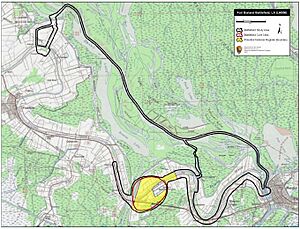Battle of Fort Bisland facts for kids
Quick facts for kids Battle of Fort Bisland |
|||||||
|---|---|---|---|---|---|---|---|
| Part of the American Civil War | |||||||
|
|||||||
| Belligerents | |||||||
| Commanders and leaders | |||||||
| Nathaniel P. Banks | Richard Taylor | ||||||
| Units involved | |||||||
| Department of the Gulf XIX Corps |
Army of Western Louisiana | ||||||
| Casualties and losses | |||||||
| 234 | 450 | ||||||
The Battle of Fort Bisland was a fight during the American Civil War. It happened in April 1863 in southern Louisiana. Union forces, led by Major General Nathaniel P. Banks, fought against Confederate forces. The Confederate army was led by Major General Richard Taylor. This battle was part of a larger plan by the Union army to control the Bayou Teche area.
Contents
Why the Battle Happened
When Nathaniel P. Banks became commander of the XIX Army Corps in late 1862, he had an important mission. He was ordered to attack a strong Confederate fort called Port Hudson. This attack was meant to happen at the same time as General Ulysses S. Grant attacked Vicksburg.
Challenges for the Union Army
Banks knew his march would be tough. The area around New Orleans was swampy and full of marshes. This meant soldiers could get sick easily. Another big problem was the small Confederate army led by General Richard Taylor. Taylor's army was in Western Louisiana.
Banks' Plan to Attack
Banks decided to move his army to Alexandria first. This would help him secure the Bayou Teche region. This area had lots of food and supplies. He planned to set up supply bases along the way. After securing Alexandria, he would then move on to Port Hudson. However, General Taylor's small army slowed Banks down. They fought a series of battles, starting with Fort Bisland.
The Battle of Fort Bisland
General Banks wanted to capture Taylor's entire army. On April 9, 1863, two Union divisions crossed Berwick Bay. They moved from Brashear City (now Morgan City, Louisiana) to the west side at Berwick. Banks began his main advance on April 11. General Taylor knew Banks was coming. His cavalry (soldiers on horseback) under Brig. Gen. Thomas Green watched the Union army closely. They reported every move back to Taylor.
First Day of Fighting: April 12
On April 12, Banks sent a third division, led by Brig. Gen. Cuvier Grover, up the Atchafalaya River. Their goal was to land behind Franklin. This would cut off any Confederate retreat from Fort Bisland. General Taylor sent some of his cavalry to slow the Union advance. He also sent troops under Brig. Gen. Alfred Mouton to stop Grover's division. Later that day, Union troops arrived near Fort Bisland. They set up their battle lines. Both sides fired cannons until dark. Then, the Union soldiers went back to their camps for the night.
Second Day of Fighting: April 13
The next morning, around 9:00 a.m. on April 13, Union forces moved forward again. Banks had three brigades (smaller groups of soldiers) south of the Bayou Teche. They faced the "Arizona Brigade" of the Confederates. North of the Bayou Teche, Union soldiers faced Mouton's Confederate brigade.
The main fighting started after 11:00 a.m. and lasted until dusk. Confederate soldiers fought from their earthworks (defensive walls made of dirt). A Confederate gunboat named Diana also fired on the Union troops. Union gunboats joined the fight later in the afternoon.
Confederate Retreat
By early evening, the firing stopped. Later that night, General Taylor learned that the Union division that went up the Atchafalaya River was now behind his army. This meant his retreat could be cut off. Taylor quickly began moving his supplies, men, and weapons out of the fort. He left a small group of soldiers behind to slow down the Union army. The next morning, Banks and his men found the fort empty.
What Happened Next
Fort Bisland was the only strong defense that could have stopped the Union advance. Now, it had fallen. Banks continued his march up Bayou Teche. His main goal was to reach Alexandria, Louisiana.
General Taylor managed to slow Banks down again a few days later. This happened at the Battle of Irish Bend.
Images for kids



